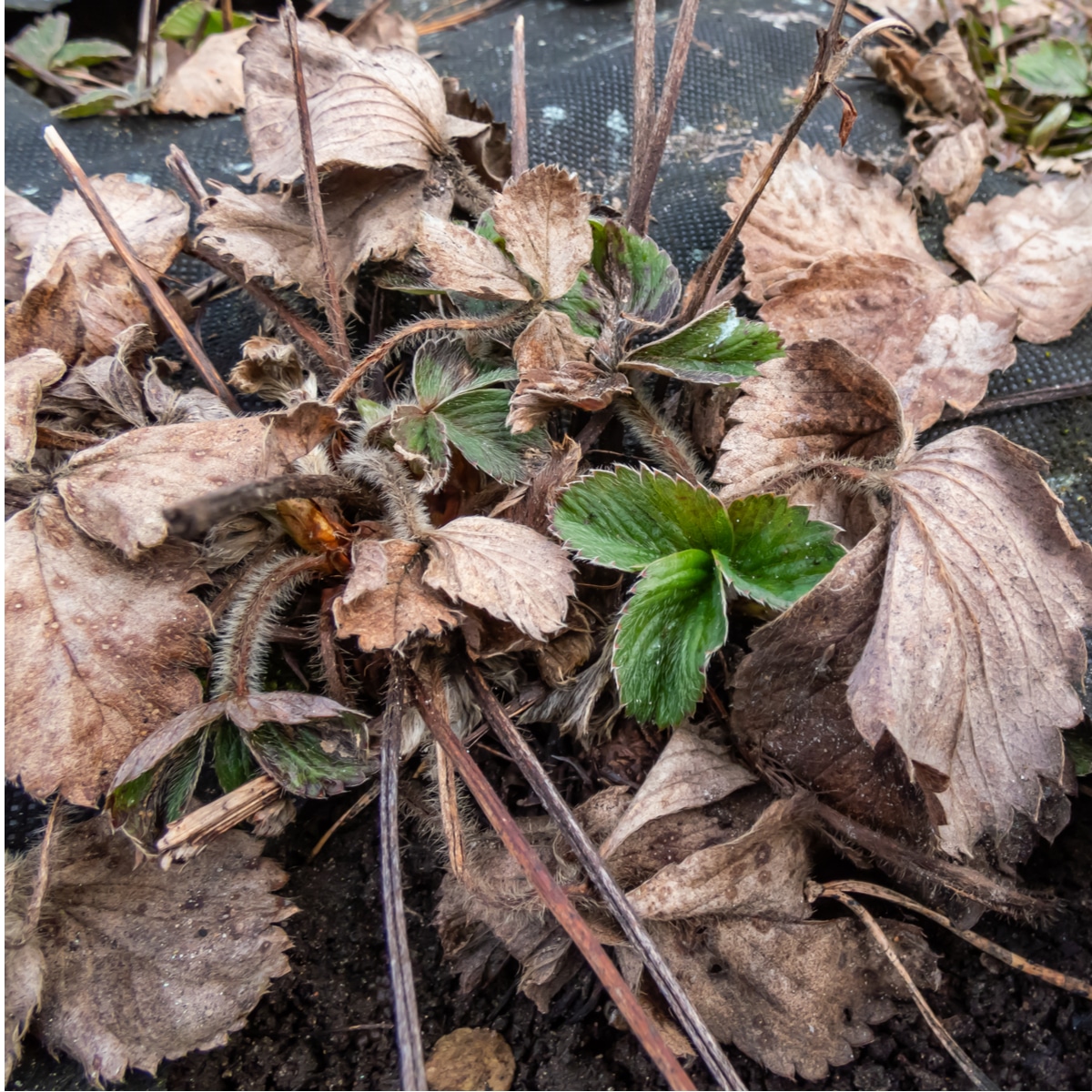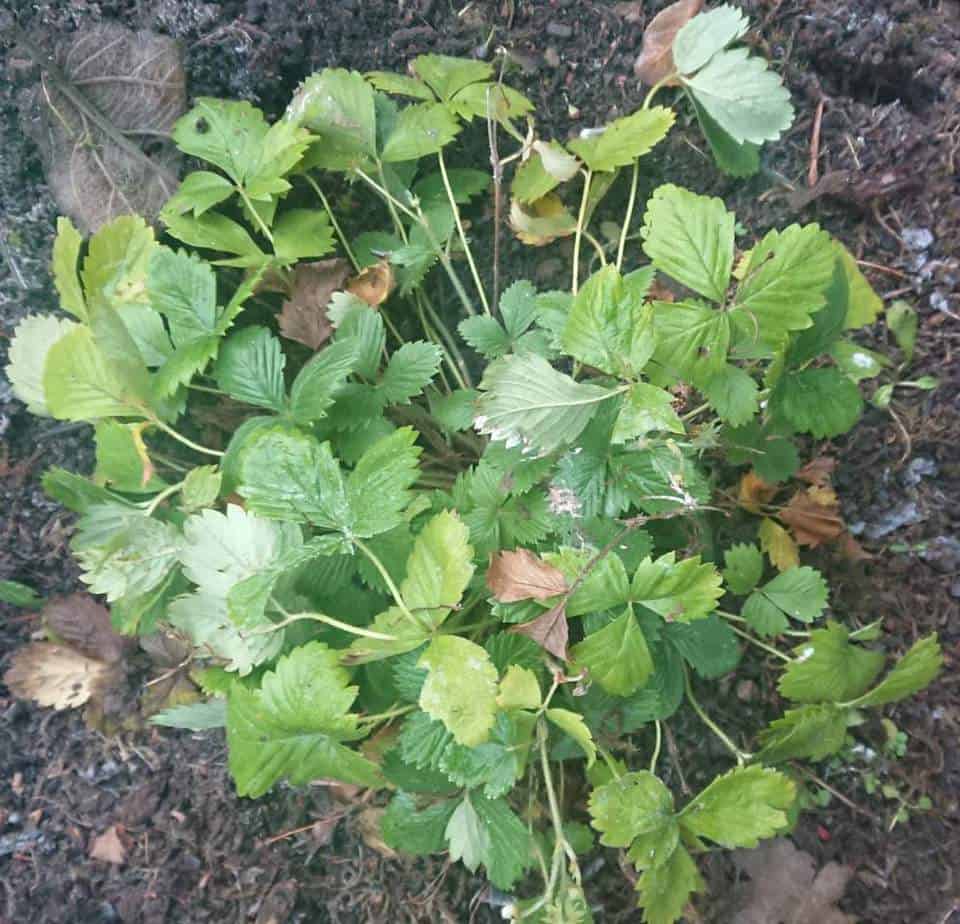Due to nutrient deficiencies in the soil, frost damage, crown rot, or drought stress brought on by inadequate watering, which causes the leaves to shrivel and become brown, strawberry plants might die. In response to excessive watering and crown rot, strawberry leaves become yellow and wither away.
Read on to discover the precise reason why your strawberry plants are dying and how to save them or stop it from happening.
It is vital to remember that strawberry plants only live for around 6 years and start to lose their fruit yield and general health after two years.
Table of Contents
Strawberry Plants Dying after Planting (Brown Leaves)
Strawberry plants seem to be dying off soon after planting for a number of reasons.
- Drought danger is increased when strawberry plants are planted insufficiently deeply.
- Crown rot can result from planting strawberries too deeply in the ground.
- not providing enough water to strawberry plants during the dry season when they are most susceptible.
Brown withered leaves and shriveled fruit are signs of a strawberry plant that has not received enough water and is thus under drought stress.
In order to keep the soil moist while the roots are established in the soil, strawberry plants should be irrigated as frequently as necessary.
Giving plants plenty of water promotes root growth, which makes them more drought-resistant.
When soil is watered too sparingly, the soil surface becomes moist but water does not penetrate to the plants’ roots, where it is needed, causing the leaves to wilt, shrivel, and turn brown.
Particularly strawberry plants grown in containers are susceptible to drought.
Pots have less capacity for soil and do not hold as much moisture. The soil tends to dry out much more quickly in full sun, so you should water pots more frequently.
If necessary, water pots as often as necessary to maintain the soil’s moisture level, which you may check with your finger or a water meter that keeps track of soil moisture levels.
If you change your watering habits, strawberry plants can typically recover from drought stress. However, this relies on how long the strawberry plant has gone without enough water.
Strawberries should be planted on soil that has been modified with compost, leaf mold, or well-rotted manure as these materials help to preserve moisture. This will help to reduce the risk of drought as much as possible.
In order to supply enough moisture for the developing fruit on the hottest Summer days, it is possible that the strawberry plant needs daily watering. This is because it must cope with the scorching heat and high temperatures.
Keep in mind that strawberry plants should ideally be planted in the spring so that the roots may develop in the soil without summer’s heat robbing the leaves of moisture before the roots can absorb adequate moisture.
If you plant strawberries in the summer, make sure to water them every day to keep them from wilting and dying.
Strawberry Plants Dying from Crown Rot
This occurs when the crown of the plant, which is where the stems meet the base, is buried too deeply, coming into continual touch with damp compost.
While the growth above ground tends to be on the drier side to ward off illness, the roots need continuous hydration.
Watering strawberry plants aloft increases the danger of crown rot because the disease is more likely to spread in an environment that is too humid and moist.
Depending on the stage of infection, crown root reduces the growth of your strawberry plant, discolors the tissue of the crown, and frequently produces brown or yellow leaves.
Once your strawberry plant has crown rot or root rot, it should be removed since it will die. The fungus that causes strawberry blight can live in the soil and infect new plants, so avoid planting any strawberry plants there.
To stop the reinfection of other plants, apply a fungicide to the soil.
To avoid fostering the circumstances for the disease, always water your strawberry plants at the base rather than overhead.
Crown rot is far less likely to affect strawberry plants that are planted at the proper depth in well-draining soil.
Strawberries should be spaced 18 inches apart to provide for adequate airflow and lower the chance of a humid microclimate, which can encourage crown rot.
Strawberry Leaves Turning Yellow and Drooping
The yellowing and wilting of your strawberry plants’ leaves is an indication of stress brought on by an excessive amount of moisture near the roots.
In order to grow strawberries, the soil needs to be both moist and well-draining. The leaves turn yellow and the root rot fungal disease, which can cause the strawberry plant to die back, is encouraged if the soil around the roots is continually moist.
Strawberry leaf color changes to yellow due to
- soils that drain slowly. Strawberries grown on heavy soils, like clay, retain too much water and are more likely to have root rot and leaf blight. Strawberries require friable, light, porous soil with good drainage. This is accomplished by adding a lot of organic matter to the soil, such as compost, leaf mold, or well-rotted manure, since these substances have a remarkable capacity to store moisture while allowing extra water to drain away from the roots, which is the ideal balance for healthy strawberries.
- pots without base drainage holes. In order for extra water to drain, strawberry plants should be cultivated in pots with drainage holes in the bottom. Some decorative pots lack drainage holes, which leads to water pooling and saturated soil, which in turn causes the leaves to turn yellow.
- very frequent watering of the strawberries. When strawberries are watered daily with a soaker hose, the surplus water does not have a chance to drain away from the roots, which encourages root rot. Strawberries need moist soil. The majority of the risk from overwatering is reduced by well-draining soil with lots of compost because of the way it is structured, which encourages extra water to flow away rather than pool around the roots. As often as necessary, water strawberries to keep the soil moist but not soggy.
The starberry plant has a chance of recovering from its yellowing appearance with well-draining soil that has been supplemented with compost, watering to keep the soil moist rather than saturated, and using proper pots and containers.
However, strawberry plants should be removed to stop the illness from spreading if they have spent a long time in soggy soil.
Strawberry Plants Turning Yellow and not Growing
The most likely reason for your strawberry plants to turn yellow despite your best watering efforts is a nutrient imbalance in the soil, which most frequently occurs in sandy or rocky soil that does not retain many nutrients.
When the foliage is expanding and the plants are producing fruit in the Spring and Summer, they are heavy feeders. Therefore, for optimal growth, they need rich, fertile soil.
Stress from inadequate soil is shown by yellow leaves and stunted growth.
Planting strawberries on soil that has been modified with compost, well-rotted manure, or leaf mold is crucial to preventing yellow leaves since these substances have a good mix of nutrients and generate the ideal balance of moisture for strawberry plants to grow.
Before planting, the soil needs to be modified to a depth of at least 10 inches.
I advise moving slow-growing strawberry plants with yellow leaves into pots or containers so that the soil profile can be more easily adjusted to meet the needs of the fruit.
To promote healthy fruit production and prevent yellowing leaves in the spring and summer, feed strawberry plants with a fertilizer that has a high potash concentration every two weeks.
Strawberries Dying from Frost Damage
Since they have not had time to acclimate to the outside, strawberry plants are most frequently damaged by late spring frosts. This is especially true if they were cultivated in a greenhouse at a nursery before being sold and put in your garden.
If your strawberry plant just has a few leaves impacted by light frost damage, it may recover if you prune back the afflicted growth and keep it safe from further frosts.
However, avoiding damage from occurring in the first place should take precedence because a late frost can completely destroy a strawberry garden’s worth of plants.
In order to protect strawberries from frost, it is a good idea to purchase horticultural fleece in advance. You can also grow strawberries in a green house or poly tunnel.
Fungal Diseases
Grey mold and powdery mildew are two fungal diseases that can affect strawberry plants.
In humid environments, grey mold with a fuzzy, grey look develops on the plant’s decaying portions like older leaves or blossoms, causing the plant to rot and wither away.
The strawberry plants’ growth is stunted by Powdery Mildew, a white fungus that causes the leaves to shrivel and curl.
Read these RHS articles to learn more about powdery mildew and grey mold.
Strawberry Plants only Live for 6 Years
Even in ideal circumstances, strawberry plants have a relatively short lifespan of about 6 years, with the best fruit appearing in the first and second years.
Strawberry plants begin to lose output during the second year and may finally die back, mainly as a result of a fungus in the soil that causes the leaves to turn brown.
Therefore, if your plants start to die after a few years, do not panic because this is only part of a strawberry plant’s natural life cycle.
Key Takeaways:
- Underwatering is typically the cause of dying strawberry plants. The strawberry plant will die if the soil is not kept continuously moist when the roots are developing because the leaves will lose too much moisture, wilt, and eventually turn brown.
- Due to soil nutrient deficits and root rot, strawberry leaves turn yellow.
- Frost damage in the spring can turn the strawberry plant’s foliage dark or black and cause it to wither.
- The fungal diseases grey mold and powdery mildew can cause strawberry plants, which only have a six-year lifespan, to die back.
FAQ
Are my strawberry roots dead?
Typically, strawberries are sold as bare roots in bags or as individual potted plants. They are simply dormant plants, bare roots. They may appear to be dead, but they aren’t—or, at the very least, they shouldn’t be!
Why have my strawberry plants died?
Due to nutrient deficiencies in the soil, frost damage, crown rot, or drought stress brought on by inadequate watering, which causes the leaves to shrivel and become brown, strawberry plants might die. In response to excessive watering and crown rot, strawberry leaves become yellow and wither away.
Will strawberry plants come back?
Strawberries: Do they reappear every year? Strawberries are perennial plants, therefore they will grow again every year. The lifespan of a strawberry plant is roughly six years, however after the first two years, fruit production noticeably declines.
Will wilted strawberry plants recover?
Give wilted strawberry plants a good soak to completely wet the soil and roots, and keep them out of direct sunshine to hasten their recovery. Additionally, you can water-spray their foliage to refresh it.



